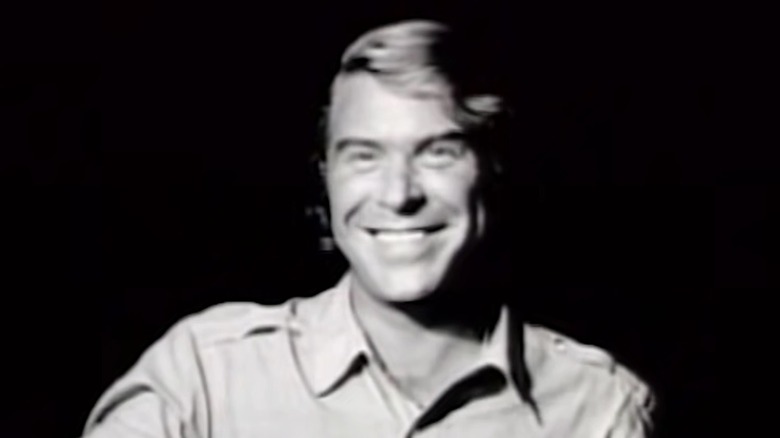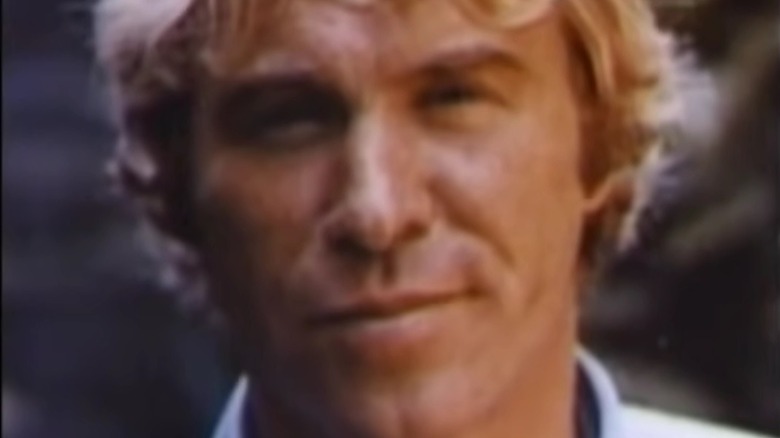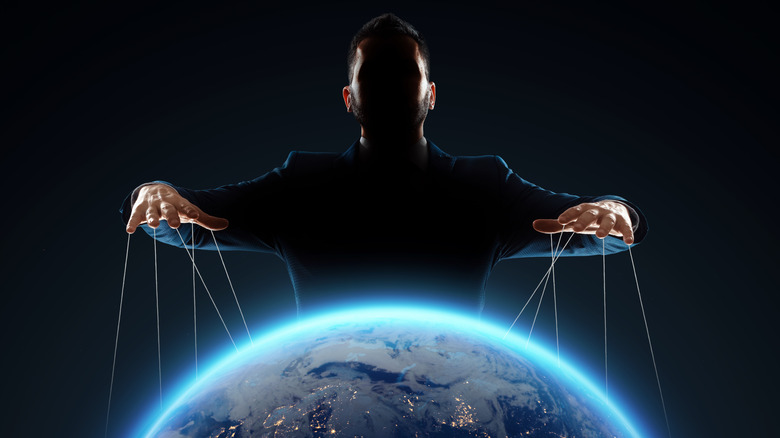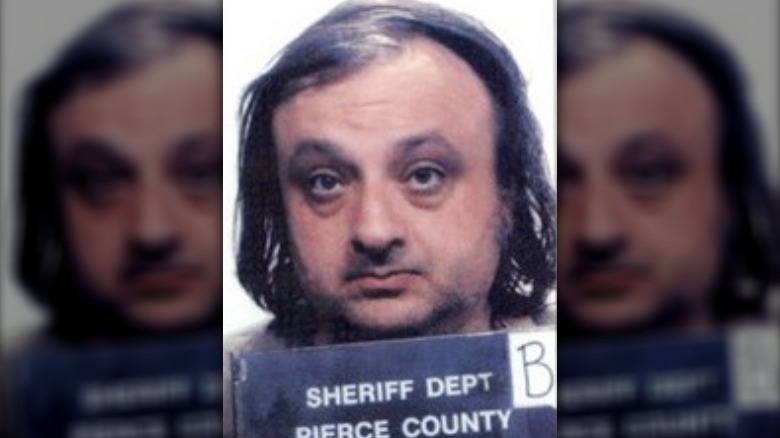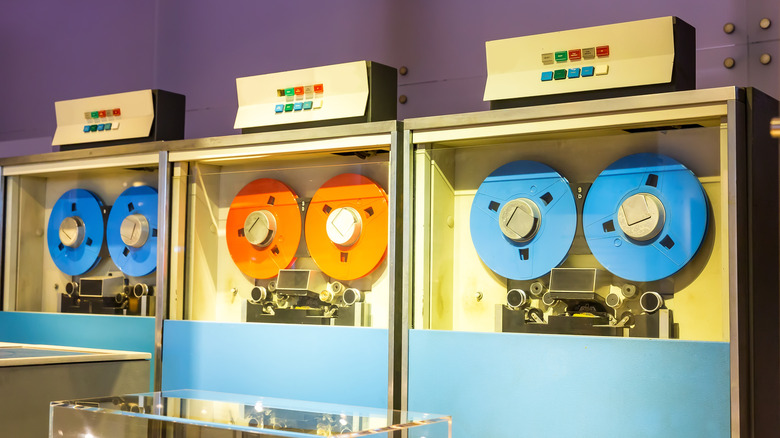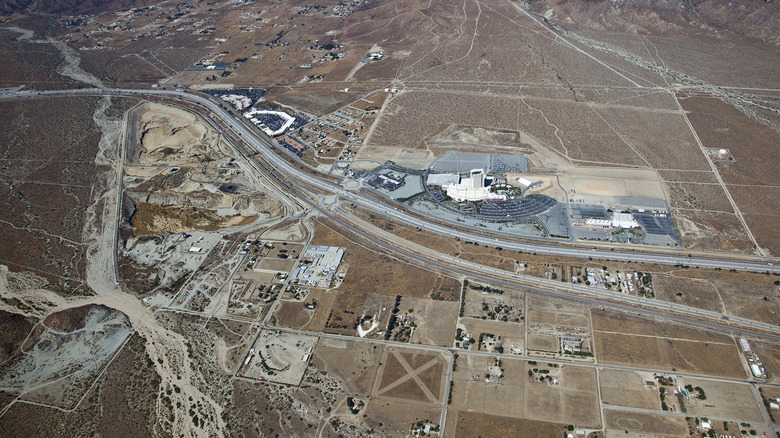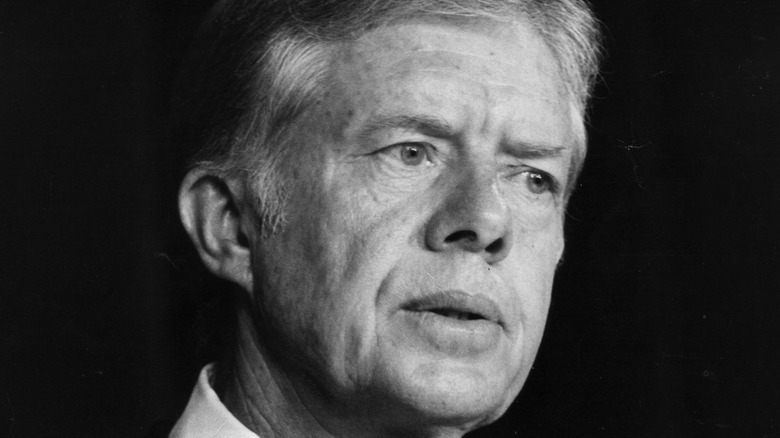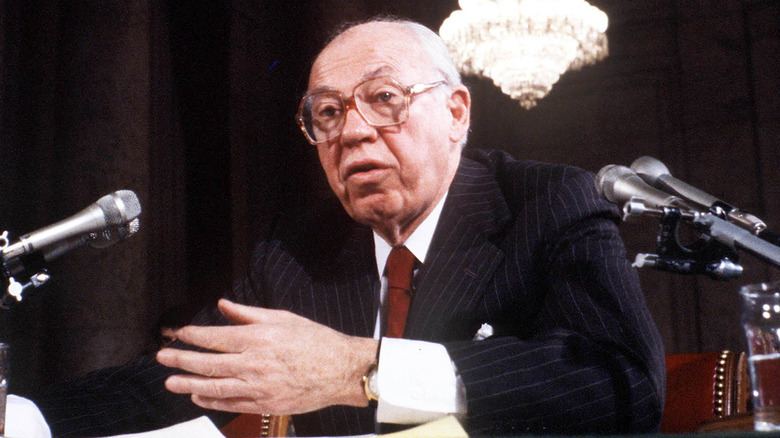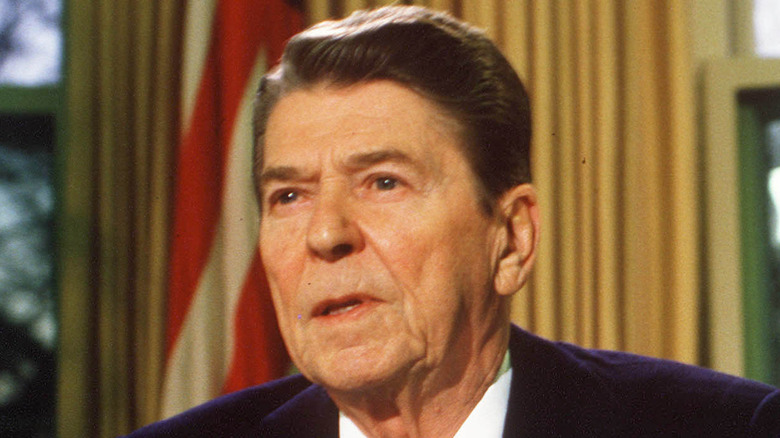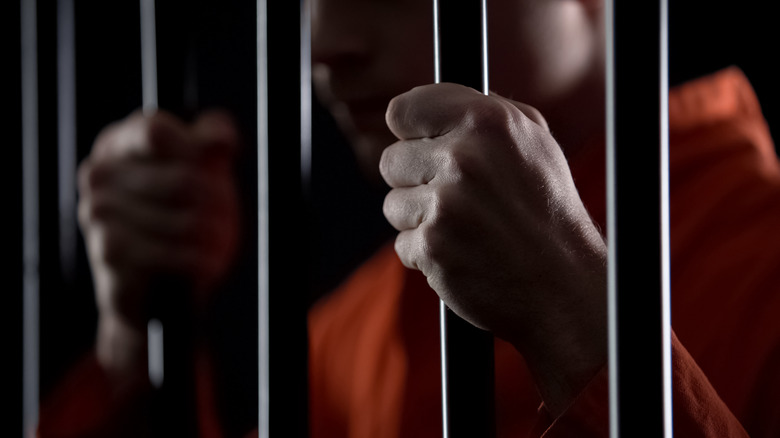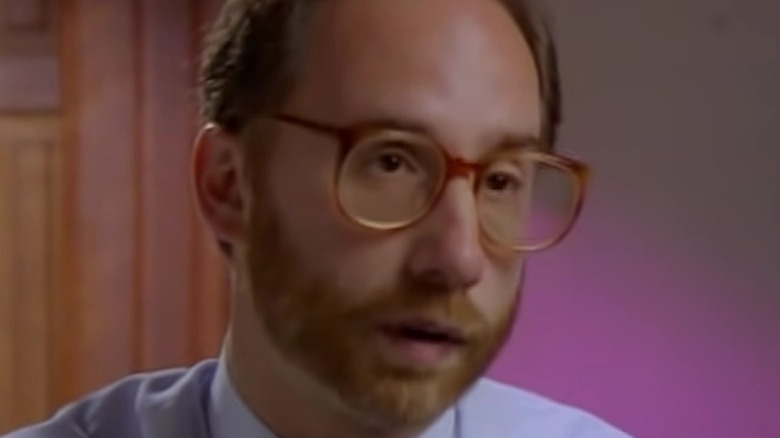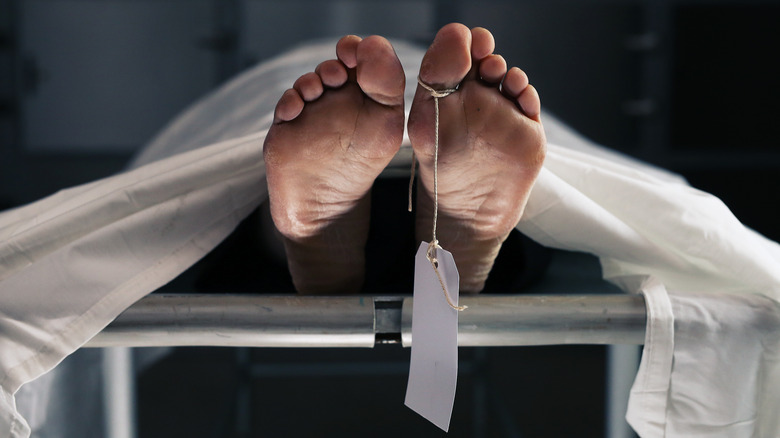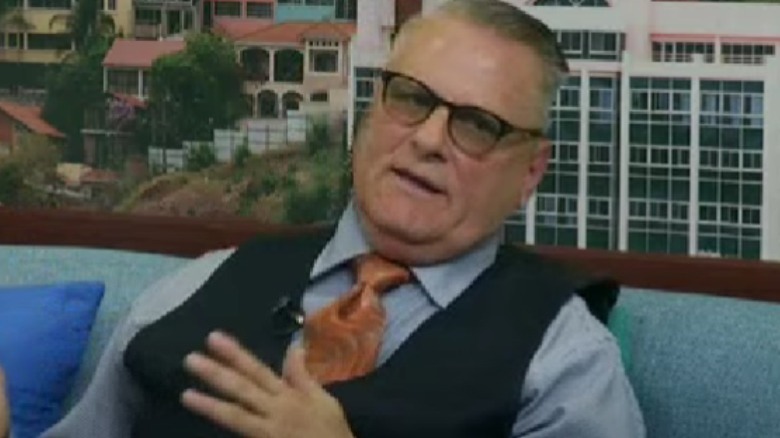The Mysterious Case Of Danny Casolaro
Conspiracy theories have gotten a bad rap lately, and there's a pretty good reason for that. Years ago, those folks that subscribed to even the most outlandish ones (and let's face it, most of them have no basis in reality) were seen as harmless crackpots at the very worst — and who among us hasn't at least entertained the idea that, say, the moon landing was faked or that 9/11 was an inside job? These days, though, going too far down such rabbit holes can lead to a place in which misinformation replaces actual information, and one's entire worldview can become dangerously skewed.
Joseph Daniel Casolaro was a freelance journalist who saw conspiracies quite literally everywhere, and who fell down a deep, dark rabbit hole for over a year — one which did indeed take him to a very dangerous place. What he found at the bottom of that hole remains a mystery — because he's no longer alive to tell us, and the voluminous notes pertaining to his investigation vanished along with his life.
His is a cautionary tale — one in which might very well lead you to the conclusion that those geopolitical forces that shape our society are far more secretive — and malevolent — than one could ever imagine.
His early career
Danny Casolaro had early aspirations to be a novelist and journalist, and with respect to the former, he began in the early '70s to carve himself a pretty distinct career path. As noted by acquaintance Ron Rosenbaum in a Vanity Fair piece published shortly after Casolaro's death, the freelancer's early work was often aimed at exposing shady deals and hidden scandals, from a decidedly right-wing perspective.
In an old resume dug up by Rosenbaum for his piece, Casolaro credited himself with being among the first journalists to expose Cuban leader Fidel Castro's United States intellligence network and efforts by the Chinese government to smuggle opium into the U.S. He also claimed to have published a highly questionable development in the infamous Watergate scandal — one which posited that disgraced former president Richard Nixon's rubber-stamping of the Democratic National Committee Headquarters break-in that precipitated his eventual resignation was the result of a set-up by Democrats.
The publications listed as having featured his work were wildly varied, from the reasonably respectable (such as the Sydney Daily Mirror) to the ... not (such as the notorious National Enquirer). But as Rosenbaum pointed out, the particular political slant of many of his pieces suggests strongly that Casolaro had significant connections within the right-wing intelligence community — or, at the very least, right-wing propagandists. This certainly seemed to still be the case in 1990, when Casolaro would begin in earnest to piece together the story that would consume him for the rest of his life.
Danny Casolaro and The Octopus
According to Ron Rosenbaum, Danny Casolaro's life took a detour in the early '80s. He had divorced his wife of 10 years and took a hiatus from journalism to focus on writing for computer trade journals, some of which he eventually acquired, as per Vanity Fair. This would have provided him with a steady income for awhile, but later in the decade, he sold off the publications for what his friends said amounted to peanuts. He became disillusioned with this career path, and in the wake of the sales, the pull of investigative journalism amid all of the myriad political scandals of the decade proved to be too strong.
According to a 1991 piece in The Nation, Casolaro's friends and family described how, for the year or so prior to his death, he had become very excited about a sort of "Grand Unified Theory" of shady international conspiracies. He was compiling research that he said would establish connections between virtually all of the major political scandals of the previous couple decades, and the title of the book he was working on was appropriately apocalyptic: "Behold a Pale Horse." When it came to his central theory, though — one which posited that a small group of individuals had their slimy tentacles in all of the dirtiest areas of the geopolitical sphere — he had a different label. Casolaro called it "The Octopus," and most of the darkest threads of his investigation were the result of intelligence supplied by one source who claimed to pretty much be at the center of it all.
His main source, Michael Riconosciuto
Michael Riconosciuto was a scientist and former intelligence operative who had already entangled himself with the players involved in the case of computer software company Inslaw by the time Danny Casolaro met him in 1990, as per Vanity Fair. The Inslaw case would become the first major thread that Casolaro began to tug on in unraveling his mother-of-all-conspiracy theories, and Riconosciuto would provide him with many, many more — but good luck getting a handle on who the man actually is, because when it comes to his life and exploits, it can be difficult in the extreme to separate fact from fiction.
Ron Rosenbaum spoke with Riconosciuto for his Vanity Fair piece, and based on his conversations and on Casolaro's notes, he determined the details of his life that were at least fairly likely to be true. Riconosciuto was a child science prodigy who developed a high-tech, argon-based laser. By the age of 16, he was working for a lauded scientist in his Stanford lab. He had high-ranking military, of the type with CIA connections, among his family members. By the early '70s, he was in trouble on charges of manufacturing narcotics, which he claims he was forced into by mysterious, nefarious individuals. And upon his release from prison he became a government informant and technical advisor. In the early '80s, he says he was hired by the U.S. government to do some shady work at a top secret facility.
Inslaw and Promis
Inslaw began as a non-profit called the Institute for Law and Family Research, founded by the husband-wife team of William and Nancy Hamilton in the '70s (via Columbia Journalism Review). Operating entirely on grants, the institute developed PROMIS, which was designed to track individual cases through different branches of the criminal justice system, from investigation to arrest to trial to prison to release and parole. In 1982, the reconstituted Inslaw — now a for-profit business — scored a multi-million dollar contract with the Department of Justice (DOJ) to modify the software for use in a complete overhaul of the DOJ's case management system, and this is apparently where the trouble started.
Inslaw filed a lawsuit against the DOJ, one which dragged on for years, for stealing their software and not paying the company. It wasn't long before Michael Riconosciuto came into the Hamiltons' orbit, and the tale he had to tell them about the DOJ's intentions with PROMIS was enough to curdle their blood. He would allege that the DOJ pirated PROMIS in order to sell it for profit to foreign governments. Aside from the blatant illegality of the move, there were also extreme ethics concerns on William Hamilton's part; he pointed out that it would only take slight modifications to PROMIS for a government to, for example, track foreign intelligence agents, political dissidents, and even ordinary citizens. Inslaw's charges against the DOJ would allege that this is exactly what was happening with its product in human rights-challenged countries like Libya and Iraq, but that wasn't even the most troubling part.
The Cabazon reservation
Michael Riconosciuto told the Hamiltons, and would later tell Danny Casolaro, that the top-secret project he was recuited for in the early '80s involved a modification to PROMIS, and it was no slight tweak. Riconosciuto said that, at the behest of a consortium of government officials operating out of the Cabazon Indian Reservation — conveniently outside the purview of U.S. federal law — he was tasked with modifying a (pirated) copy of the PROMIS software, as Riconosciuto would later outline in an affadavit submitted in federal court. His modification would allow U.S. intelligence agencies to spy on the activities of any government to whom the pirated software had been sold — a function, obviously, which is pretty far outside the scope of what the Hamiltons had intended, according to an article in the zine, Steamshovel Press (via University of St. Louis, Missouri archive).
Riconosciuto would also tell Casolaro, per The Nation, that he was personally involved with other shady goings-on at the Cabazon facility. He alleged that, as part of a jointly financed operation between the CIA and the infamous security organization Wackenhut, he had been working on next-generation military weaponry. These weren't even the sketchiest of the pictures that Riconosciuto had to paint about his work for the intelligence community, however. He alleged that the profits from the illicit sale of PROMIS didn't simply flow to government coffers but were earmarked for specific "services rendered"(via Columbia Journalism Review) — and that some of those services were tied directly to some of the biggest scandals and conspiracy theories of the '80s, as per Vanity Fair.
The October Surprise
You may think of the term "October Surprise" as meaning "any dirty trick pulled by a political party to smear the opposition right before an election," but the term has a definitive origin. In 1980, incumbent Democratic President Jimmy Carter was doggedly pursuing the return of American hostages being held in Iran, per Rutgers Today; his failure to get this done had him trailing Republican challenger Ronald Reagan in the polls. The hostages would be freed in early 1981 (via Britannica), but Carter's failure to produce an "October Surprise" — to secure their freedom right before the election — likely contributed to his defeat, and conspiracy theorists have long speculated that Reagan's team may have conspired with Iran to hold the hostages until after the election, helping to ensure their guy's victory.
This, said Michael Riconosciuto, was exactly the case. In a 1990 conversation with William Hamilton (via The Nation), Riconosciuto claimed that he and Earl Brian, a member of then-California governor Reagan's cabinet, had personally traveled to Iran with a payment of $40 million for the Iranian government to keep the hostages in captivity until after Reagan was elected president. Hamilton would allege in Inslaw's lawsuit that a portion of the funds raised by the DOJ for its illegal sale of PROMIS went to Brian for his part in this endeavor — an allegation that came directly from Hamilton's conversations with Riconosciuto.
The BCCI scandal
Peppered throughout Michael Riconosciuto's conversations with Ron Rosenbaum and Danny Casolaro are references to BCCI (via Vanity Fair) — the Bank of Credit and Commerce International. According to the Guardian, the bank at its peak had 417 branches in 73 countries — but in 1991 it suffered an astounding collapse, reporting liabilities of nearly $20 billion. According to Riconosciuto, the bank was used by the CIA and other international intelligence agencies to funnel money toward all manner of shady activities. In light of what became public about BCCI after its collapse, this is not difficult to believe.
BCCI's problems began in 1986, as per the IRS website, when an investigation by U.S. Customs uncovered the fact that it was actively soliciting business from Colombian drug traffickers (via Express Tribune). According to the IRS website, further investigation revealed that the bank was not only involved in money laundering activities for high-rolling criminals but operated as a clearing house for illicit payments by and for the CIA and foreign intelligence agencies — it was even alleged that the bank's president, Agha Hasan Abedi, had met privately on multiple occasions with then-CIA director William Casey. In addition, it was found that BCCI had contracts with agents working covert operations on behalf of the U.S. government — up to and including those involved with the single biggest political scandal of the '80s.
The Iran-Contra affair
The infamous Iran-Contra scandal, in which the U.S. government (eventually) admitted to selling arms to the hostile nation of Iran in exchange for the promise of freed U.S. hostages — and for straight-up cash, some of which was funneled to the right-wing guerrillas known as the Contras, who were embroiled in conflict with the socialist government of Nicaragua (via Britannica) — rocked the '80s. Michael Riconosciuto had fed Danny Casolaro's suspicions that a portion of the government's profits from his work on the Cabazon reservation had been earmarked for the Contras, and near the end of his life, Casolaro believed he had found a smoking gun indicating just that, according to Vanity Fair.
This was a single document: a photocopy of a $4 million check drawn on the BCCI account of Saudi arms dealer Adnan Khashoggi, a key figure in the Iran-Contra scandal. It was made out to one Manucher Ghorbanifar, an Iranian arms merchant living in exile who had allegedly served as a contact between U.S. intelligence and the Contras (per "The Octopus: Secret Government and the Death of Danny Casolaro," by Kenn Thomas and Jim Keith). Casolaro's friend Ben Mason explained to Ron Rosenbaum that Casolaro believed this check to be the key piece of evidence validating all of Riconosciuto's allegations — a validation that was strengthened when Riconosciuto made a sinister prediction that proved to be accurate.
The source's prediction comes true
According to Vanity Fair, Michael Riconosciuto told Danny Casolaro in February 1991 that he had been approached by an unnamed, high-ranking DOJ official about the Inslaw case, which at that time was under investigation by a House Judiciary Committee. This official allegedly told Riconosciuto to keep his nose out of it — that if he were to offer up any information to the committee, he would soon be regretting it from behind bars. Riconosciuto chose not to heed this advice, going public the next month (per CJR). He asserted his belief that the Hamiltons deserved justice for the fraud perpretated on them by the DOJ, and it was then that he filed his affadavit with the committee alleging that he had been warned off providing any information to the committee under threat of imprisonment.
Not even a week after filing that affadavit, Riconosciuto was indeed arrested and thrown in jail on charges of manufacturing and distributing speed, per Vanity Fair, in an eerie case of history repeating itself. Of course, Riconosciuto claimed to have been set up, and that the chemicals he was caught with were actually for use in a process he was developing for refining platinum ore. For Casolaro, it was proof positive that Riconosciuto was on the level — and later in 1991, he would tell friends and family that he had finally discovered the source that was going to blow his whole investigation wide open.
A fateful trip
In the week before his death, Danny Casolaro was not just optimistic about the direction of his investigation, his friends and family say that his mood was downright triumphant. According to Ron Rosenbaum in Vanity Fair, Casolaro told them that he was going to West Virginia to obtain the final piece of the puzzle from a source that would help him tie all of the threads that he had been pursuing over the previous year into a neat package. He was, he told one friend, on his way to "bring back the head of the Octopus."
However, he also seemed to be keenly aware that he was wading into potentially dangerous waters. He had previously confided in his brother, Dr. Anthony Casolaro, that William Hamilton had warned him that his investigation carried grave risks (per The Nation), and he had also reported receiving anonymous, threatening phone calls at his home, which was confirmed by his neighbor, notes Vanity Fair. Before his departure to West Virginia, Danny Casolaro gave his brother an explicit instruction. If anything were to happen to him there, and if it were to look like some kind of accident, Anthony was not to believe it.
A highly suspect suicide
As reported by the Washington Post, Danny Casolaro was discovered by the housekeeping staff of the Sheraton hotel in Martinsburg, West Virginia, on the morning of August 10. He was naked in a tub of cold water, with as many as a dozen deep slashes to both wrists, reports another article in The Washington Post. According to an autopsy report, he had traces of both a prescription painkiller — prescribed to him after a dental procedure three years earlier — and an antidepressant in his system, which is curious, as Dr. Anthony Casolaro asserts that his brother was never treated for depression. His voluminous notes on the Octopus investigation were nowhere to be found, as per Vanity Fair.
The Post quotes Casolaro's friends and family members as stating with certainty that Casolaro was not only not suicidal. He was known to be extremely squeamish — to the point of fainting at the sight of blood — and modest, rarely allowing others to see him unclothed. Obviously, those who knew Casolaro had a lot of questions — but they got no answers. His alleged suicide note, found at the scene, was never released to relatives; his body was quickly autopsied and enbalmed, on a Sunday, before said relatives had even been notified. Per the Buffalo News, retired police officer and Casolaro acquaintance Theodore Schendel, one of the last people to see Casolaro alive, offered up a blunt assessment in 1993 after looking into the case: "Danny was murdered."
Does The Octopus live on?
In 2011, Wired spoke with Rachel Begley, who claims to have picked up the threads of Danny Casolaro's investigation. As a teen, Begley's father had been murdered along with a girlfriend and a friends in an incident that police later determined may have had some connection the top-secret activities at the Cabazon reservation. Begley discovered this potential connection while doing online research and quickly became immersed in the world of those online denizens who believe the Octopus to be alive and well.
Her digging eventually led her to a man who had been mentioned to police in connection with her father's death: a self-proclaimed ex-hitman for American intelligence, now a preacher living in Honduras, named Jimmy Hughes. Partially through her efforts, Hughes was extradited to California to be brought up on murder charges — charges that were, due to what the judge vaguely described as "new information" and a reevaluation of the available evidence, suddenly dropped.
Begley's online presence has diminshed over the last decade, but her experience seems to suggest that if indeed Danny Casolaro got too close to the truth, those responsible for his death are no less vigilant than they ever were. Begley herself is quite convinced that is the case, and she offered a chilling prediction. "You're going to find out real soon," she said, "that the world isn't what you think it is."
